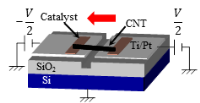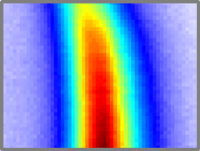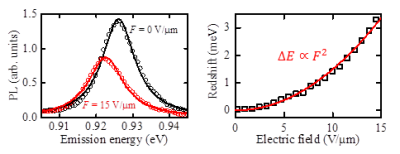Research:Stark effect of excitons in individual air-suspended carbon nanotubes
The Stark effect is a redshift of an energy level caused by electric fields. A well-known example is the Stark effect in hydrogen atoms (electron-proton pairs), treated in many textbooks of quantum mechanics. In the case of excitons (electron-hole pairs) in carbon nanotubes, the effect is also important. By using the Stark effect, control of absorption or emission energies becomes possible, which would lead to wavelength-tunable detectors and emitters.
Here we investigate electric-field effects on photoluminescence from chirality-assigned individual air-suspended carbon nanotubes within field-effect transistor structures.


The bottom left figure shows photoluminescence spectra taken with electric fields F = 0 V/um and 15 V/um. The emission peak with F = 15 V/um shows a redshift as well as a reduction of intensity compared to F = 0 V/um. The decrease of photoluminescence can be explained by spontaneous exciton dissociation in the carbon nanotube. The redshift scales quadratically with electric field (bottom right figure), showing that the shift is caused by the Stark effect. Furthermore, we find that theoretical predictions are in quantitative agreement.

To learn more about this work, please refer to:
Stark effect of excitons in individual air-suspended carbon nanotubes
Appl. Phys. Lett.
105, 161104 (2014).
![]()